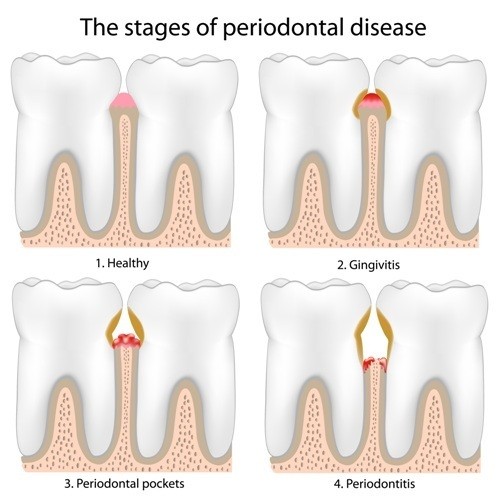Gum Disease Treatment and Maintenance
When most people think of the dentist, they think of a doctor who cares for your teeth – but dentistry is so much more than that! Another of the major parts of oral health care, a part that many people forget about, is caring for your gums. In fact, many people have disease and infections in the gums and don’t realize it until it’s at an advanced stage. If you notice any of the following signs, there is very likely an infection that needs treatment:

- Redness or swelling: Unfortunately, for most patients this redness and swelling comes on so gradually that they hardly notice it.
- Bleeding: This can be especially prevalent while brushing, flossing or eating. Some patients even report bleeding from pressure.
- Teeth look longer: The expression “long in the tooth” referring to someone who is older has a lot to do with the fact that gums recede with age and disease. Your teeth aren’t actually lengthening. Periodontal disease eats away the alveolar bone beneath the gums and the gums begin to pull away from the tooth.
- Loss of stability: If your tooth begins to feel loose or to shift out of the position they used to be in, this may be a sign that the teeth supportive tissues, gums and alveolar bone, are too diseased to be able to hold your teeth as firmly as they should.
- Sores: if you are noticing tender spots, red spots, white spots, pus or open sores anywhere in your mouth, not just on the gums, there may be an underlying infection that needs treatment.
- Bad breath: Bad breath that is persistent is a tell-tale sign of infection somewhere in the mouth or in the digestive tract. In the cases where the infection is in the mouth – it is normally located in the gums and may even move into a tooth or onto the tongue.
- Bite changes: If your jaws fit differently together, if you are finding yourself losing teeth, if your dentures or bridges or alignment devices fit differently or not at all, this change may be the result of an advanced infection.
Now that you know some of the signs, take a deep breath and relax. Periodontal disease is not at all uncommon. Most people will have some sort of gum infection at some point in their lives. Thankfully, treatment for periodontal disease can be very simple and very effective in the early stages. In fact, for many patients, the only treatment that is required is a deep cleaning. A visit with the hygienist to remove built up plaque and tartar as well as foreign particles that are stuck in the teeth is sometimes enough treatment. Those particles tend to hold onto decay and disease-causing microbes; getting rid of them is often enough to allow your body to naturally fight off the infection and return to normal. Another treatment possibility is having a scaling and planning done. This procedure is done under a local anesthetic and removes plaque and tartar from above as well as below the gum line and also smooths out any rough spots on the root where infection might be prone to taking hold. In some cases, antibiotics can be injected into and under the gums for treatment.
For more advanced cases, surgical intervention may be needed. Surgical treatments may be anything in a wide range of potential solutions, depending on the cause and severity of your infection.
